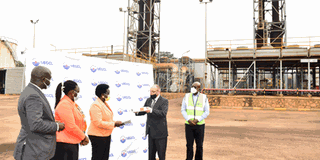Prime
Govt to convert Namanve power plant into gas production unit

Ms Nankabirwa (C), receives documents during government’s takeover of the Namanve thermal plant in September last year. PHOTO / STEPHEN OTAGE
What you need to know:
According to Energy Minister Ruth Nankabirwa, government has already secured a memorandum of understanding with the government of Tanzania to convert Namanve Thermal Power Plant into a Liquefied Petroleum Gas production unit.
The Ministry of Energy has said it is engaging the government of Tanzania to convert the recently repossessed Namanve Thermal Power Plant into a Liquefied Petroleum Gas production unit.
Speaking during the unveiling of the Consumer Protection and Installation Permits Centre in Kampala last week, Energy Minister Ruth Nankabirwa, said at an undisclosed date, she will be unveiling the whole plan of turning the Namanve Thermal Power Plant into a Liquefied Petroleum Gas manufacturing facility.
“I will be unveiling the whole plan of the Namanve Thermal Power Plant, which uses fossil fuel. I cannot keep quiet when we are converting it into clean energy using natural gas. I have a memorandum of understanding with [the government of] Tanzania to convert it into a Liquefied Petroleum Gas unit,” she said, noting that she would divulge details when the time is ripe.
The development comes barely a year after government took over the management and maintenance of the thermal power plant, which had been running under a concession since 2007.
Government had entered into a 13-year build, own, operate and transfer concession with Jacobsen Elektro, which had been generating 50 megawatts of electricity.
However, the concession expired in 2021, after which government took over the plant, which is currently being managed by Uganda Electricity Generation Company Limited.
The plant has previously been cited as one of the electricity generation points, alongside the Tororo-based Electromaxx in Tororo, that provide the most expensive electricity, which government buys at $18 cent (about Shs666.04) for every unit.
Uganda currently relies on imports of liquefied petroleum gas to feed an estimated demand of 8,000 cubic metres.
However, the country is expected to produce at least more than 300,000 tonnes of liquefied petroleum gas per annum during the oil peak production, which is close to the total amount of the gas currently being consumed in the whole of East Africa.
While receiving the Namanve Thermal Plant in September last year, Ms Nankabirwa noted that the plant was still an important facility, saying much as the country had excess electricity, in case of any calamity such as drought and moving suds, where electricity generation is reduced, the country would depend on it for constant supply of electricity.
Meanwhile, Eng Zilia Tibaalwa Waako, the Electricity Regulatory Authority chief executive officer, said at the launch of the Consumer Protection and Installations Permits Centre that as regulators, they were excited about the centre because it will be key in protecting the interests of electricity consumers.
The centre, she added, will also help grow the number of certified electricians in order to effectively support government programmes of accelerating access to clean energy across the country.
“Besides consumer protection and installation permit services, this building will also be utilised as a centre for regional cooperation and coordination, research, innovation and consultancy,” she said, noting that the centre will handle all complaints made by electricity consumers, concerning electricity services provided by licensed companies.
Eng Zilia Tibaalwa also noted that as a regulator they now have a fully-fledged consumer affairs unit to hand residual consumer complaints, which have not been adequately addressed by licensed companies.




